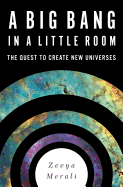
What if humans could create a new "baby universe," one filled with stars, galaxies, black holes and even sentient beings similar to ourselves? And if we could, should we? These are the two major questions science journalist Zeeya Merali discusses in A Big Bang in a Little Room, a fascinating look at the incredibly complex world of modern physics.
Scientists worldwide, many of whom are interviewed here, are in the process of computing how it would be possible to create such a new "baby universe" in a lab, possibly through the use of a particle collider such as the Large Hadron Collider. Merali does an excellent job of laying out the foundations of quantum physics so that the average reader can understand it, without introducing the difficult mathematics behind the process. She builds one idea on top of another when discussing black holes, Hawking radiation, monopoles, string theory and multiverses, among many other ideas. Gradually she moves toward her goal of proposing the concept of universe building, and the moral and ethical obligations scientists would face if they suddenly were able to accomplish this feat. Intertwined throughout the science is the concept of religion, of whether God is the one behind all of this conjecture and math. Regardless of one's beliefs, Merali encourages readers to think outside the known parameters of space-time and three-dimensionality, and instead contemplate seemingly farfetched ideas that in the near future may be within our grasp. --Lee E. Cart, freelance writer and book reviewer

